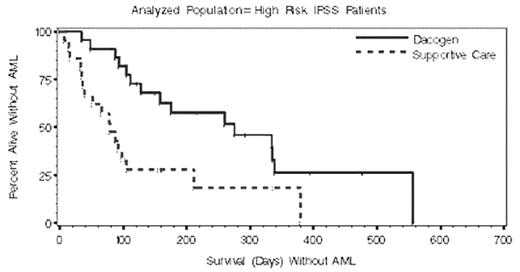Abstract
MDS is a disease of the elderly marked by dysplasia of hematopoetic cell lines resulting in cytopenias and AML progression. There is currently no treatment approved to alter the natural history of the disease. Aberrant methylation associated with cancer is a potential target for pharmacologic therapy, and DacogenTM (decitabine) for injection (SuperGen, Inc.), a cytosine analogue, indirectly depletes methylcytosine after incorporation into DNA with subsequent inactivation of DNA methyltransferases. We report the results of a Phase III trial of decitabine (DAC) vs. supportive care (Supp.Care) in adult MDS patients with IPSS Intermediate (Int)-1 (31%), Int-2 (44%) and high risk disease (26%). Secondary MDS (14%) and previously treated (27%) MDS patients were not excluded. Bone marrows were assessed by a blinded, independent pathologist. 170 patients (accrued from July 2001 through April 2003 at 23 centers) were randomized 1:1 to either Supp.Care or DAC (a 3 hr infusion of 15mg/m2/hr every 8 hrs on 3 consecutive days every 6 wks for up to 10 cycles. The groups were comparable for numerous risk factors, including time from diagnosis (median 29 weeks for DAC and 35 weeks for Supp.Care). Kaplan Meier (KM) curves for time to AML progression or death showed early and clinically meaningful separation (consistent with clinical benefit) in favor of DAC in all patients (intent to treat; ITT), Int-2/High Risk, and High Risk patients. Using the Cox proportional hazards model for the ITT population, the probability of progression to AML or death was 1.68-fold greater for Sup.Care than for DAC (p=0.023).
Median Time to AML or Death (Days)
| MDS group (n) . | DAC . | Supp.Care . | . | p-value . | |
|---|---|---|---|---|---|
| 1Protocol specified test. 2Preferred test for analysis of early separation of KM curves. | |||||
| n=89 | n=81 | Wilcoxon1,2 | Log rank1 | ||
| All Patients (170) | 338 | 263 | 0.046 | 0.204 | |
| Int-2/High Risk (118) | 334 | 189 | 0.005 | 0.040 | |
| High Risk (44) | 260 | 79 | 0.001 | 0.006 | |
| Treatment naïve (124) | 354 | 189 | 0.005 | 0.034 | |
| MDS group (n) . | DAC . | Supp.Care . | . | p-value . | |
|---|---|---|---|---|---|
| 1Protocol specified test. 2Preferred test for analysis of early separation of KM curves. | |||||
| n=89 | n=81 | Wilcoxon1,2 | Log rank1 | ||
| All Patients (170) | 338 | 263 | 0.046 | 0.204 | |
| Int-2/High Risk (118) | 334 | 189 | 0.005 | 0.040 | |
| High Risk (44) | 260 | 79 | 0.001 | 0.006 | |
| Treatment naïve (124) | 354 | 189 | 0.005 | 0.034 | |
Investigator reported response rate by International Working Group criteria was 25% (10% CR, 15% PR) for DAC vs. 0% for Supp.Care (p< 0.001), with responses equally distributed across baseline subgroups. Time to response was 100 days and median duration was estimated at >9 months. Responders (CR and PR) vs. non-responders had a median survival of 678 days vs. 406 days (p= 0.038 Wilcoxon). There were no treatment related deaths. As expected, grade 3–4 toxicity (including hematologic toxicity, febrile neutropenia) occurred in more DAC patients than in Supp.Care patients. Most patients tolerated treatment well. DAC appears a promising therapy for MDS with manageable toxicity. Final results of independently reviewed response rates and clinical benefit (transfusion independence; Quality of Life) will be presented.
Author notes
Corresponding author


This feature is available to Subscribers Only
Sign In or Create an Account Close Modal